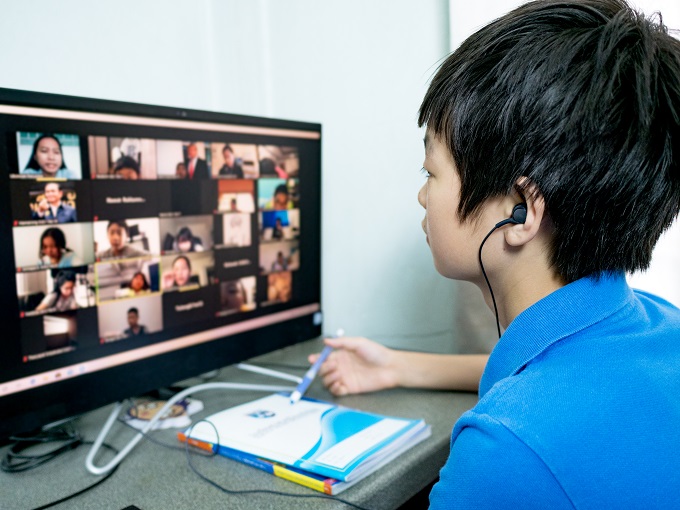
As a first-grade teacher for nearly a decade, I enjoyed nothing more than teaching early readers to unlock the code and discover the joy of books. Three years ago, I was hired as the literacy coach for my district. In this role, I led professional development sessions on teaching reading in the primary grades, training teachers and support staff on explicit, systematic instruction, and managed committees on English language arts curriculum.
Then in response to the COVID-19 outbreak, our district moved to remote learning. Everything I had been teaching other educators involved in-person, hands-on instruction. I was dismayed. How could we ever reproduce literacy instruction in a distance learning format?
But no matter the venue, whether on-site, remote, or a hybrid format, teachers can continue delivering high-quality literacy instruction. The following tips have helped me, and I hope will do the same for others tasked with teaching reading and writing virtually.
1. Remember your classroom must-dos.
When teaching reading, replicate good practices virtually. As you would with a traditional lesson plan, begin with your goal in mind and then consider how it can be achieved through the screen. What do you want the students to learn? How can you get them there? Then consider your learning plan, materials, and opportunities for practice and frequent feedback.
For example, our primary-grade teachers deliver daily phonics lessons with the learning goal that students will accurately encode and decode words with a targeted skill. Teachers must start with explicit instruction, just like they would in the classroom. In a remote setting, rather than using printed letter cards, use an online letter program such as Really Great Reading. Or, when it’s time for guided practice, have students create letter tiles on small pieces of paper to manipulate at home.
Encourage participation by asking different groups to answer a question using a cue such as “Everyone wearing a red shirt unmute yourself and share out.” For individual practice, have students submit a picture of written work through digital platforms like Seesaw or Google Classroom. As you would in the classroom, form small groups for remediation or enrichment. You can schedule a breakout room or office hours for students who need more one-on-one support.
2. Let parents in on the learning.
Understandably, most parents are not experts in reading instruction. Part of our job during remote learning has been to provide parents with tools to support their children and give parents context and background about the instructional practices we use. Sharing the purpose of strategies and routines and offering specific ways to help at home is critical.
I put together a bitmoji classroom for parents. This page includes a range of videos, from the technical side (the five pillars of literacy) to the practical (what is phoneme segmentation, and how can I do it at home?). When I communicate with parents, I offer this page as a resource for at-home practice. For those who are not easily able to help with work at home, they can at least build an understanding of the work their child is doing.
3. Mix it up!
One of the biggest complaints I have heard from teachers (and students) amid the pandemic is that they are teaching whole-group lessons for long blocks of time. This is not something we typically do in elementary school. So, let’s consider how that can be adjusted for virtual learning.
What if you create small groups for learning centers? After setting up expectations, create five breakout rooms. Just as you would in the classroom, pop into each room for a few minutes to answer questions, check progress, and monitor behavior.
Is there an opportunity for students to work in pairs, writing together? Create different Google slides, each with a prompt, and assign two students to each slide. To make it purposeful, come back together and have partners share out with the whole class.
Do the students need to work on something independently? Have the students turn on their cameras, set a timer on the screen, and let them work at their own pace. Then, come back together to check on their status and make instructional decisions based on their progress.
4. Take it off screen.
Students need to read to learn to navigate text. Reading aloud to students or just guiding them through activities is not enough. Give students time to read away from the computer screen. I know releasing that control over to students, not knowing what they are doing when you can’t see them, can be scary. But I encourage you to give them off-screen tasks and gather feedback on how they do. Make the learning purposeful, and the students will be engaged in the task.
For example, our third-grade students have to find text evidence from the nonfiction book Giant Squid: Searching for a Sea Monster by Mary M. Cerullo. When off screen, the students can look through the text to find interesting facts and write those down to share the next day. Students can use this information to create something—a paragraph, a drawing, or a diorama—allowing students to express creativity, own their learning, and demonstrate understanding.
That there is a lot lost during remote learning is true. I miss the clamor of a full classroom talking excitedly about a favorite book, the coming together around the carpet for meetings and lessons, and the expressions of friendship you see on the playground and in the cafeteria. But if we get creative, focus on what matters, and work diligently to meet students’ needs, we can still teach in joyful and effective ways.
Katy Tarasi is an elementary literacy coach in the Avonworth School District near Pittsburgh, PA, and a fellow with the Great Minds’ Wit & Wisdom English Language Arts team. In that capacity, she delivers professional development and coaching to educators around the United States.